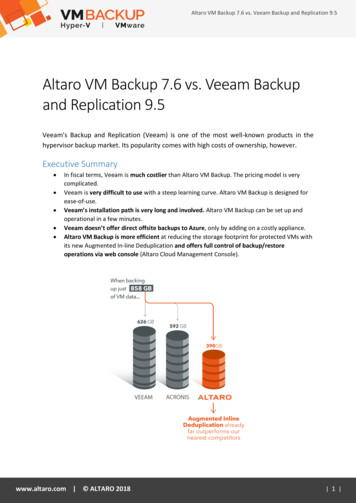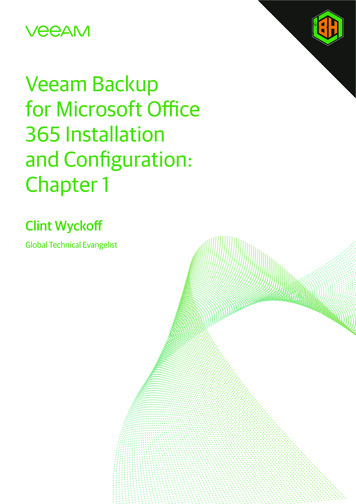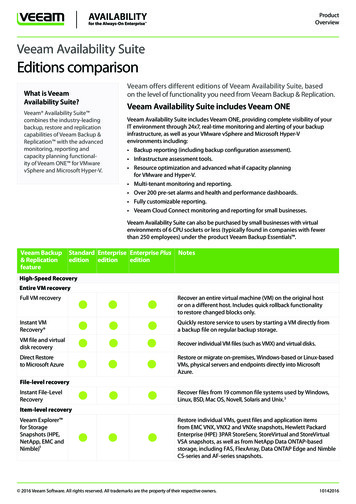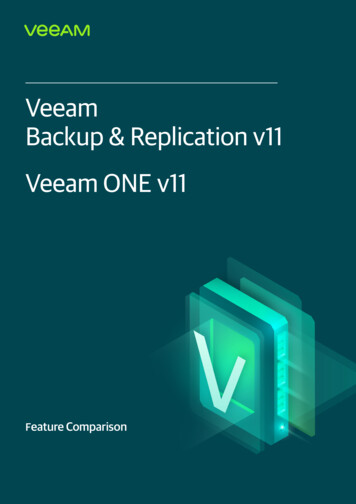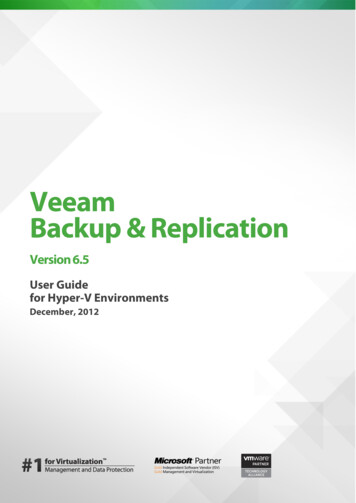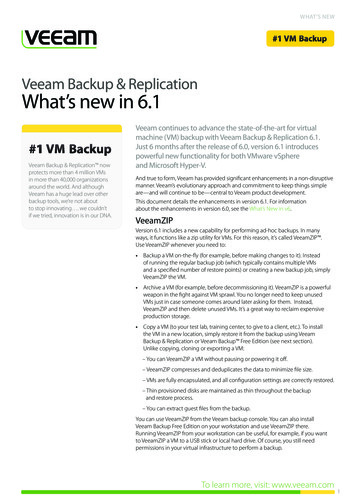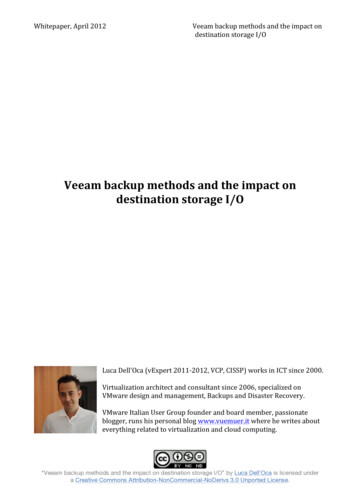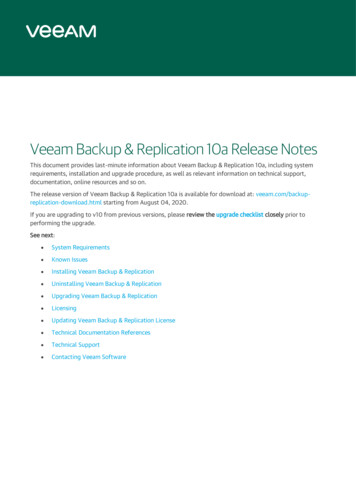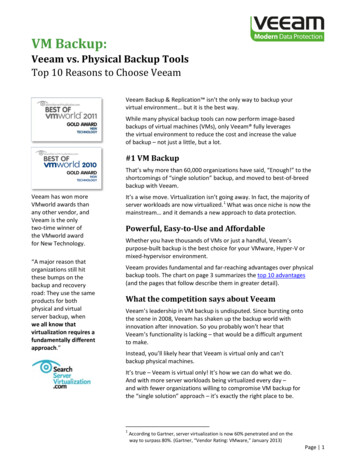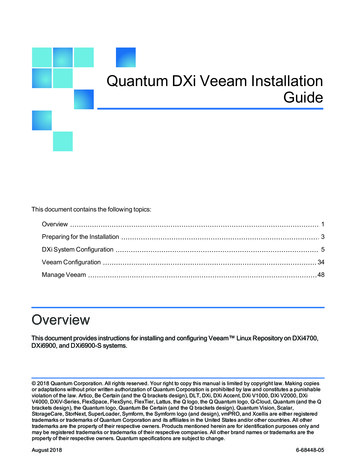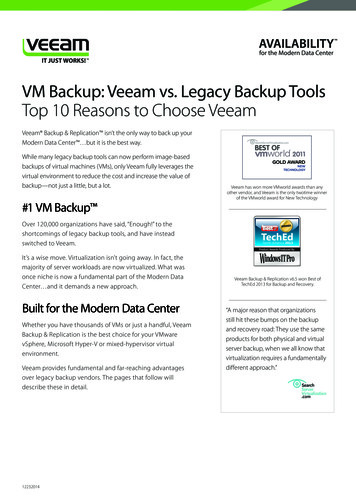
Transcription
VM Backup: Veeam vs. Legacy Backup ToolsTop 10 Reasons to Choose VeeamVeeam Backup & Replication isn’t the only way to back up yourModern Data Center but it is the best way.While many legacy backup tools can now perform image-basedbackups of virtual machines (VMs), only Veeam fully leverages thevirtual environment to reduce the cost and increase the value ofbackup—not just a little, but a lot.#1 VM Backup GOLD AWARDNEWTECHNOLOGYVeeam has won more VMworld awards than anyother vendor, and Veeam is the only twotime winnerof the VMworld award for New TechnologyOver 120,000 organizations have said, “Enough!” to theshortcomings of legacy backup tools, and have insteadswitched to Veeam.It’s a wise move. Virtualization isn’t going away. In fact, themajority of server workloads are now virtualized. What wasonce niche is now a fundamental part of the Modern DataCenter and it demands a new approach.Built for the Modern Data CenterWhether you have thousands of VMs or just a handful, VeeamBackup & Replication is the best choice for your VMwarevSphere, Microsoft Hyper-V or mixed-hypervisor virtualenvironment.Veeam provides fundamental and far-reaching advantagesover legacy backup vendors. The pages that follow willdescribe these in detail.12232014Veeam Backup & Replication v6.5 won Best ofTechEd 2013 for Backup and Recovery.“A major reason that organizationsstill hit these bumps on the backupand recovery road: They use the sameproducts for both physical and virtualserver backup, when we all know thatvirtualization requires a fundamentallydifferent approach.”
What the competition says about VeeamVeeam’s leadership in VM backup is undisputed. Since bursting onto the scene in 2008, Veeam has shaken upthe backup and data protection world with innovation after innovation. So you probably won’t hear that Veeam’sfunctionality is lacking, since that would be a difficult argument to make.Instead, you’ll likely hear that Veeam is virtual only and can’t back up physical machines.It’s true—Veeam takes full advantage of virtual architecture to do things not possible with physical servers and legacybackup tools. It’s how we can do what we do. And because virtualization is a fundamental component of the ModernData Center, it’s exactly the right place to be.Legacy backup tools were built for the physical world and simply retrofitted for virtualization. Their roots are in thephysical world, which constrains what they can do for VMs.But Veeam is different. Veeam is built for the Modern Data Center and it shows. For example:Physical backup tools Veeam Require agents inside each VMfor granular recovery and properapplication backup and recovery.Is completely agentless. Agents arenot used to perform or assist withbackups, and agents are not used forrecovery either.While others claim to be agentless for certaintypes of backups and/or restores, only Veeam isagentless in every circumstance.Make it difficult to find VMs ornavigate the virtual infrastructure.Is intuitive and easy to use. Veeamfeels like it was built for virtualizationbecause it was!As one Veeam customer put it: Our legacybackup tool felt like a bolt-on piece ofequipment—like protecting the virtualenvironment was an afterthought. Veeam feelslike it was built specifically to support VMs.Often take months to providesupport for new vSphere andHyper-V releases—and eventhen, support is often just basiccompatibility.Provides the best timely, advancedsupport for new versions of vSphereand Hyper-V.Since Veeam does not have to carry legacysystems support baggage, Veeam can providebetter and deeper hypervisor-specific supportmuch faster than legacy vendors.Veeam doesn’t simply tolerate the virtual environment, we embrace it. By harnessing the disruptive power ofvirtualization, we provide data protection beyond anything you could have imagined. One Veeam customer calls it“science fiction come true. ” We call it Virtualization-Powered Data Protection, and it changes what you should expect—and what IT stakeholders and regulators will ultimately demand—from backup.Of course, we can’t take all the credit. It’s virtualization that makes what we do possible, like recover a VM in twominutes or less directly from a backup, automatically test the recoverability of every backup and eliminate agents—even for advanced file and application-item recovery.Look closelyMost backup tools have their roots in the physical world, and some capabilities are not available with image-based VMbackups. For example, some legacy backup tools might offer synthetic full backups for traditional file-based backups,but don’t have this capability for image-based VM backups. Likewise, OS-level or log-based replication for selectapplications might be available, but not image-based VM replication. In addition, compression and deduplicationmight be available, but not recommended for use in vSphere environments or require in-guest agents to be leveraged.
Veeam vs. legacy backup toolsWhen it comes to VM backup, Veeam provides numerous advantages—both technical and commercial—over physicallegacy backup tools. Here are the top 10 advantages according to Veeam customers and partners:Veeam Backup & ReplicationLegacy backup tools1. Agentless2. Built-in advanced replication3. Instant VM Recovery (patented)4. Instant File-Level Recovery5. Instant application-item recoveryAny OS and file systemWindows, maybe LinuxAny application and file systemSelect applications only6. Automated recovery verification(patented)7. Built-in, source-side compressionand deduplication8. Simple offsite backups9. Storage agnostic10. Easy to deploy and configure1.15 minutes to self-setupWeeks of extensive deploymentAgentlessLegacy backup tools rely on agents, and they apply this approach to VM backups as well. Some can do a basic crashconsistent, image-based VM backup without an agent (e.g., using VADP, the vSphere APIs for Data Protection), but theystill require agents inside VMs for essential functions like granular recoveries and application-consistent backups.Even if agent licenses are included “for free,” agents add operational cost to backup and recovery. Worse yet, theyintroduce risk. !Considerable time is required todeploy, monitor, maintain andupgrade agents in every VM.The time requiredto maintain agentstranslates to real costs.Agents don’t protect:Backup agents in VMs can alsocreate compatibility issues andcomplicate troubleshooting for“real” VM workloads.Agents also consumehost resources, thusreducing serverconsolidation ratios. Newly provisioned VMs Powered-off VMs VMs with outdated agents or missing prerequisites VMs whose agents can’t communicate with the backupserver (e.g., due to network isolation)
Veeam fully embraces virtualization, which eliminates all these issues by eliminating the need for agents:VADP (for vSphere) andstandard Windows APIs (forHyper-V) eliminate the need fordata mover agents inside VMs.Image-based backups (whichcapture the entire VM) eliminatethe need for application and filesystem indexing and the agentsthat perform it.If properly designed, the remaining guestprocessing can be done by a lightweight, nonpersistent run-time process, eliminating the “agentmanagement hell” and other problems associatedwith agents.Veeam performs advanced backup and recovery without the use of agents in VMs. This doesn’t mean that Veeam lacksfeatures that legacy backup tools require agents to deliver, such as application-aware backup and recovery, applicationlog truncation, granular application-item recovery, Windows and Linux guest file system indexing, or in-place filerestores. Veeam provides all these features and more without agents in VMs.(back)2.Built-in advanced replicationLegacy backup tools often require different tools and separate licenses in order to replicate your VMs off site. WithVeeam, you get advanced VM replication built right into the product, allowing you to easily maintain a copy of yourbackups on offsite secondary storage.Built-in WAN AccelerationOne way customers often attempt to speed up their offsite backups is through a WAN accelerator. While generalpurpose WAN accelerators can do an excellent job, by definition they have limited content awareness and are not ableto take advantage of all of the traffic reduction capabilities that a content-aware, purpose-built WAN accelerator can.For this reason, Veeam Backup & Replication includes Built-in WAN Acceleration with functionality specifically tunedfor Veeam data transfers across the WAN. What this means is that when you need to either replicate your data or copyyour backups to an offsite location, Veeam can determine what data blocks are already there, and as a result, sendless data across the WAN connection. Veeam’s Built-in WAN Acceleration includes global caching, variable lengthdata fingerprinting, traffic compression, and more. And it’s up to 50x faster than a standard file copy. Due to its fullyintegrated nature, enabling network traffic encryption does not ruin data reduction ratios, as is the case with generalpurpose WAN accelerators.Simple site failoverOnce your data is stored at a secondary location, Veeam also provides a built-in orchestration engine, giving you easy1-Click site failover when needed. An additional “planned failover” capability is also available to facilitate data centermigrations with zero data loss.(back)3.Instant VM RecoveryVeeam’s vPower technology runs a VM directly from a compressed and deduplicated backup file on regular backupstorage. This patented, groundbreaking technology eliminates the need to extract the backup and copy it toproduction storage—you simply start the VM from the backup (that’s why it’s called “instant”). If a VM goes down, youcan restart it on any host in a matter of minutes and users can keep working while you troubleshoot the problem.
Back in a snapIn an independent lab test commissioned by Veeam, it took under 1.88 minutes to perform an instant recovery of a200GB vSphere VM, compared to 2.4 hours for standard VM recovery from an image-based backup on disk using alegacy backup tool. That’s 77x faster!Furthermore, the time to do an instant recovery with Veeam remained under 2 minutes, even as the size of the VMincreased.An instant recovery of a 16GB Hyper-V VM took just 7 seconds, compared to 9.95 minutes for standard VM recoveryfrom an image-based backup. That’s 85x faster! And once again, the time to do an instant recovery remained essentiallyunchanged even as the size of the VM increased.Back to normalVeeam Instant VM Recovery is like a “temporary spare” for your VMs. To complete the recovery, Veeam will migratethe VM running from the backup to production storage for you, using the best method available (VMware StoragevMotion, Microsoft Hyper-V Live Migration, Veeam Quick Migration, etc.). Depending on the method, full recovery canhappen in the background, with no interruption in service or impact on users.Not even closeLegacy backup tools have no equivalent instant recovery capability. They may try to expedite recovery with “liverecovery” of data volumes or “CBT restore,” but they still operate within the conventional “restore then restart” paradigm.While Veeam too provides a CBT restore option, it is important to keep in mind its limitations, which Instant VMRecovery is free from, such as: Doesn’t work in most common recovery scenarios, including VM deletion and loss of a complete LUN Cannot be relied upon in disasters caused by storage issues or host power loss Introduces additional risks due to not restoring blocks that are “known” to vSphere as unmodified, but that mighthave been corrupted on storage by the incident precipitating the restore Doesn’t support Microsoft Hyper-V(back)4.Instant File-Level RecoveryUnlike traditional file-based backups, image-based backups allow for quick recovery of an entire VM on any host,without having to rebuild the system from scratch. But recovery of individual guest files can be a challenge.Given that file-level recoveries are the most common recovery scenario—often occurring on a daily basis—thischallenge must be overcome in order for organizations to adopt image-based backups.First to marketFrom the very beginning, Veeam has provided file-level recovery from image-based backups. In fact, Veeam inventedInstant File-Level Recovery (IFLR), which allows IT admins to restore guest files directly from a compressed anddeduplicated image-based backup, without having to restore the entire VM first (that’s why it’s called “instant”).IFLR was initially available for Windows and then for Linux, Unix, BSD, Novell, Solaris and other file systems using patentpending Veeam technology based on an IFLR helper appliance.
Extending the leadWith support for 17 different file systems, Veeam already holds a substantial lead over other backup tools. And withvPower, Veeam has extended its lead, with the ability to restore individual files from any guest OS and file system,without restoring or starting up the VM at the desired restore point.1-Click File RestoreVeeam further extended its lead with 1-Click File Restore, which allows organizations to securely delegate Windows filerestores to help desk operators. 1-Click File Restore: Leverages guest interaction APIs Requires no agents in VMs Requires no additional permissions for help desk operators Can be limited to direct restores only (so operators never have access to sensitive files) Can be limited to specified file types and even specific VMs on per-operator basisGood enough?Some legacy backup tools offer file-level recovery for Windows (and in some cases, Linux) VMs, but special indexing ofeach backup is typically required. If you forget to enable the special indexing, file-level recovery is not possible. If your environment can’t tolerate the additional processing required to index file system of large file servers, filelevel recovery is not possible. File-level recovery for many OSs and file systems is not possible at all. In-place restores, if available, typically require agents in VMs, and direct network connection from a backup server toa target VM.(back)5.Instant application-item recoveryWith Veeam Explorer technology for e-discovery and granular recovery, application-item recovery just got a lot fasterand easier. Now you can zero in on exactly what you need to recover and restore individual items directly from yourbackups. There is a Veeam Explorer for the following applications:Microsoft Exchange: Get instant visibility into Exchange 2010 and 2013 backups, advanced search capabilities, andquick recovery of individual Exchange items (emails, contacts, notes, etc.) and Online Archive mailboxes—even harddeleted itemsMicrosoft Active Directory: Search and restore all Active Directory (AD) object types, such as users, groups, computeraccounts and contacts—even user and computer passwordsMicrosoft SQL Server: Get fast transaction-level recovery of SQL databases, including agentless transaction logbackup and replay, so you can restore your SQL databases to a precise point in time and achieve low recovery time andpoint objectives (RTPO )
Microsoft SharePoint: Browse SharePoint 2010 and 2013 backups, search for specific SharePoint files and quicklyrecover items directly to their original SharePoint server or send them as an email attachmentIn addition to Veeam Explorer, Veeam also offers its vPower technology, enabling recovery of individual objects fromany virtualized application, on any OS, without restoring the entire VM first. For example, you can recover individualrows and tables from an Oracle database running on Solaris, or individual customer records from a Unix-based CRMsystem.We call it U-AIR , or Universal Application-Item Recovery. It’s an innovative, patented solution to the age-old problem ofwhat to do when users accidentally delete important emails or scripts incorrectly update records.What it means for youU-AIR addresses the limitations of existing object-level recovery methods. U-AIR is: Inexpensive: Doesn’t require agents, additional backups or additional software tools Universal: Works with any virtualized application and the application’s native management tools and permissions Durable: Not tied to application internals so it’s easy to maintain and works seamlessly with new applicationpatches and releasesThe alternativeSome legacy backup tools offer object-level recovery, but: Object-level recovery is available for only a few specific applications Special agents are required, and in many cases, separately created backups or special metadata collection are alsorequired The additional backup processing can be quite resource-intensive and/or slow, so customers often limit their use ofobject-level backup and recovery (e.g., only do granular backups of executives’ mailboxes) If the special processing fails for any reason (even if the backup job reports success), you cannot recover applicationitems at all(back)6.Automated recovery verificationOf course, you can’t do any sort of recovery—instant or otherwise—if your backups are bad. But how do you knowif your backup is unrecoverable? Even if a backup job completes successfully and the backup file passes its integritycheck, you might not be able to recover from the backup. For example: The system you’re backing up may be in an unbootable state (e.g., a critical configuration file or registry key mighthave been deleted or corrupted) There might be installation, update or system reconfiguration tasks pending reboot A hot backup might have captured the system or application data in an inconsistent stateThe only way to be sure that you can recover from a backup is to do a test restore. All the backup vendors know this.But testing every backup is simply not possible unless you have Veeam.
SureBackupVeeam SureBackup allows you to verify the recoverability of your backups—not just a few selected backups, but everybackup, of every VM, every time.This patented technology: Automates the recovery verification process Uses available resources in the existing production or test environment Does not affect your backup windowDuring recovery verification, SureBackup: Creates a VM in an isolated Virtual Lab (which Veeam automatically creates and manages for you) Runs the VM directly from the backup file using vPower Starts the VM, boots the OS and confirms that applications inside the VM are running normally Can even test a group of dependent VMs (e.g., DNS server, domain controller and Exchange Server)Virtual Lab for ReplicasNot only can you verify recoverability of your backups with SureBackup, with Virtual Lab for Replicas, Veeam hasextended its Virtual Lab capabilities beyond the local backup environment to cover disaster recovery (DR) sites as well.This powerful capability allows you to: Perform automated replica verification (test failover) to ensure that your replicas are available if needed Create isolated test environments that are exact copies of your production environment, but that use DR siteresources—not production resources—so that you can try out software updates, OS patches, or other changesbefore applying them to your production environment—without any negative impactHow many other backup solutions increase the value of your existing idle resources by putting them to productivework?Don’t settle for lessYou no longer have to settle for backups that “might work” or “should work.” Instead, you can rest easy knowing thatyour backups—whether local or remote—actually do work and are available when needed.(back)7.Built-in source-side compression and deduplicationWhile many backup vendors offer various ways to reduce your growing data footprint, most of the time thesesolutions require agents and/or do not work as well in virtual environments.Veeam offers built-in source-side compression and deduplication that was specifically designed with virtualservers in mind. With Veeam, you don’t have to treat your virtual servers as if they were physical servers byinstalling an agent in each of them in order to deduplicate your data.
Veeam’s multi-pronged approach to reduce the size of backups (as well as network bandwidth consumption)includes the following:DeduplicationMany VMs have the same OS and/or applications installed, making image-based backups idealcandidates for deduplication. That’s why Veeam included deduplication from the beginning. Infact, Veeam was the first vendor to implement deduplication in a VM backup product. Veeam’sinline, source-side, block-level deduplication typically results in a 10x reduction in networktraffic and backup storage consumption. And it’s included at no charge.CompressionTo further reduce backup size, Veeam can also compress backup files.Whitespace removalVM disks often contain empty blocks, and Veeam excludes these from backups to save space.Swap file exclusionData contained in swap files isn’t necessary when recovering VMs or VM data, so Veeamexcludes them from backups.Single backupWith Veeam, you only ever need one backup regardless of what kind of recovery operationyou might need to perform. Full VM recovery, granular, application-item recovery and instantfile-level recovery are all available from the same image-based backup for any virtualizedapplication and any guest OS.“Forever incremental”backupsSynthetic full backups eliminate the need for periodically running and transferring the data ofcomplete full backups by creating new, synthetic, full backups from incremental backups. This“forever incremental” approach to backup is both proven and desirable because it reduces loadon the production environment.In fact, forever incremental is the only way to protect very large VMs that would otherwise takethe better part of a day—or even longer—to back up (even with the fastest and most efficientbackup tool). Likewise, forever incremental is essential when backing up off site over a WAN.Synthetic full backup can also reduce backup storage requirements by 60% or more. Forexample, say you have a 100GB VM and your organization’s policy requires you to keep 30days of backups on disk. Assuming 5% of the data changes daily, if you were to take weekly fullbackups and daily incrementals, you would need 655GB of backup storage. But with a singlesynthetic full backup and incrementals, you need only 250GB of backup storage—a savings of62%.(back)8.Simple offsite backupsWhen it comes to protecting your data, many customers struggle with maintaining a proper DR site. Often, it can becostly and time-consuming to get backups off site.To help mitigate this impact, Veeam Backup & Replication offers some key features to make it faster, easier and morecost-effective to get your backups off site.Built-in WAN AccelerationAs referenced earlier, Veeam offers a Built-in WAN Acceleration capability that’s specifically tuned for Veeam datatransfers across the WAN. This is not only useful for replication, but for copying backups off site as well.Backup Copy jobsBuilt-in WAN Acceleration can be used with Veeam’s Backup Copy jobs feature. This feature provides an automatedway to copy VMs to either local or remote storage locations. It also enables proper backup and retention policies (e.g.,grandfather/father/son) to help meet long-term retention requirements. Together, Built-in WAN Acceleration withBackup Copy jobs provide an easier, simpler way to get your backups off site.
Connect to the cloudTo make storing offsite backups even easier, Veeam also offers the ability to seamlessly store your backups in the cloudbackup repository hosted by a service provider, with Veeam Cloud Connect. Your backups can be created or copied offsite over the Internet securely through an SSL-protected connection. Veeam Cloud Connect enables offsite protectionwithout the need to invest in a second site.SecurityFinally, you might be wondering how safe your data is as it moves from one storage location to another across theWAN. To mitigate these concerns, Veeam offers end-to-end encryption, allowing you to secure your data via AES 256bit encryption in three different locations: At source (during backups), before it leaves your network perimeter In flight as your data is transferred At rest, which includes hardware and software tape encryptionThese three encryption options provide flexibility with regard to when and where you can leverage encryption.With the combination of Built-in WAN Acceleration, Backup Copy jobs, Veeam Cloud Connect, and end-to-endencryption, along with the ability to send your backups off site to disk, cloud or tape, Veeam Backup & Replicationoffers a flexible, secure, simple way to more easily and cost effectively get your backups off site.(back)9.Storage agnosticVeeam is storage-agnostic, so you can use it with any mix of production and backup storage across data centers,remote offices and DR sites. Customers appreciate this flexibility, which: Avoids vendor lock-in Optimizes storage spend Makes it easy to integrate acquired companies Allows old production storage to have a new life as backup storage(back)10. Easy to deploy and configureWith a product as powerful as Veeam Backup & Replication, it must be expensive and time consuming to install, right?After all, the typical legacy backup solution requires weeks to deploy, even with a team of expensive consultants, andoften just to upgrade from one version to the next!But the power and elegance of Veeam Backup & Replication extends beyond its feature set such that installationand deployment can occur in a fraction of the time and expense. With Veeam Backup & Replication v7, individual ITadministrators reported 60 minutes to download, install, configure and complete a full backup of 25 VMs!Compare that to legacy, agent-based legacy backup solutions, which normally require weeks of professional services tobe deployed.(back)
SummaryLegacy backup tools are typically considered for VM backup by organizations already using those tools. While it mightbe convenient to back up everything—both physical and virtual—with one tool, what is the cost of doing so? What doyou lose by choosing a single legacy solution over one specifically built for the Modern Data Center?As this document illustrates, you lose a lot.The Modern Data Center—including virtualization—offers the opportunity to significantly enhance data protectionand reduce costs, but you need the right tool to turn opportunity into reality. Already, Veeam has made this a reality forover 120,000 customers. Isn’t it time you made Veeam part of your Modern Data Center?
Veeam vs. legacy backup tools When it comes to VM backup, Veeam provides numerous advantages—both technical and commercial—over physical legacy backup tools. Here are the top 10 advantages according to Veeam customers and partners: Veeam Backup & Replication Legacy backup tools 1. Agentless 2. Built-in advanced replication 3.
